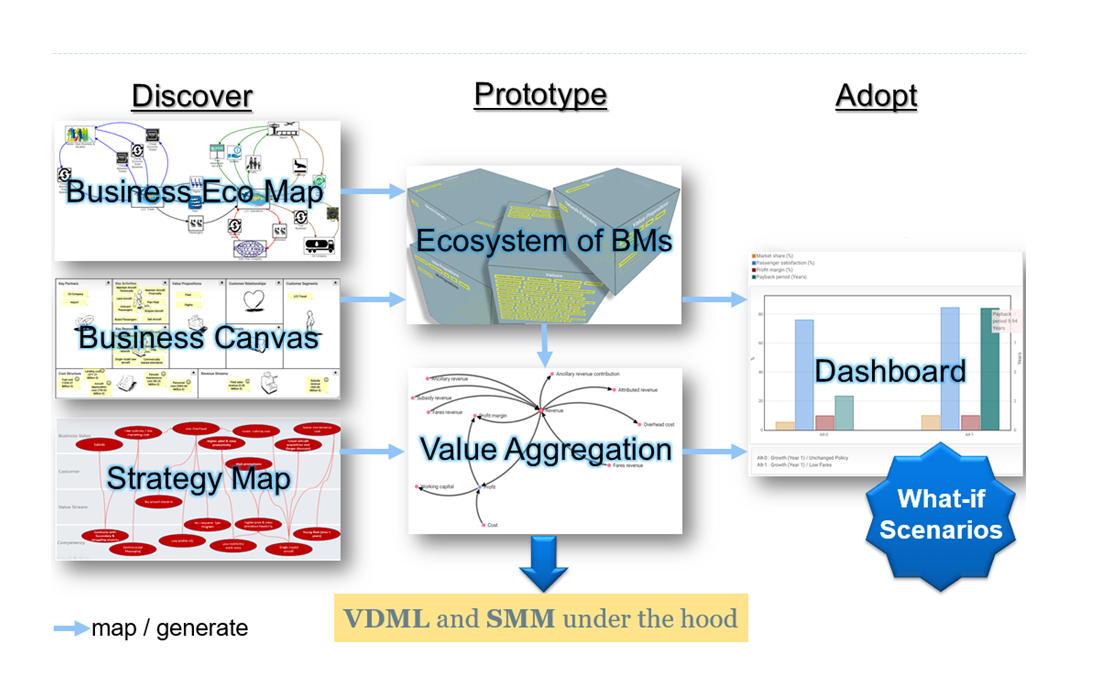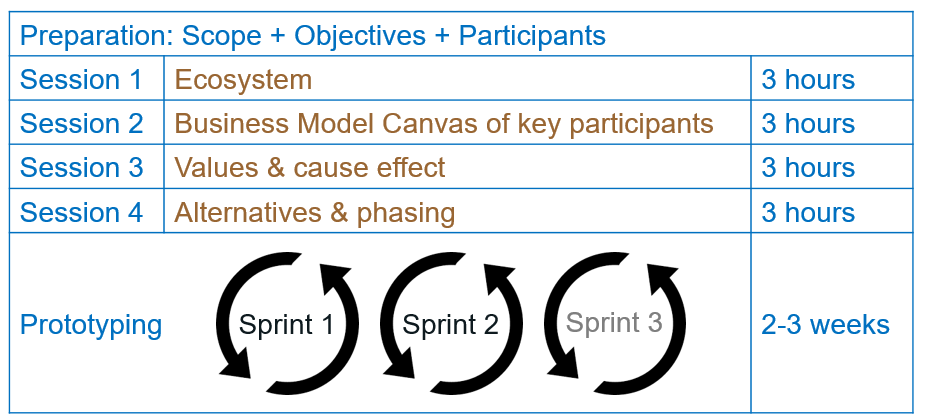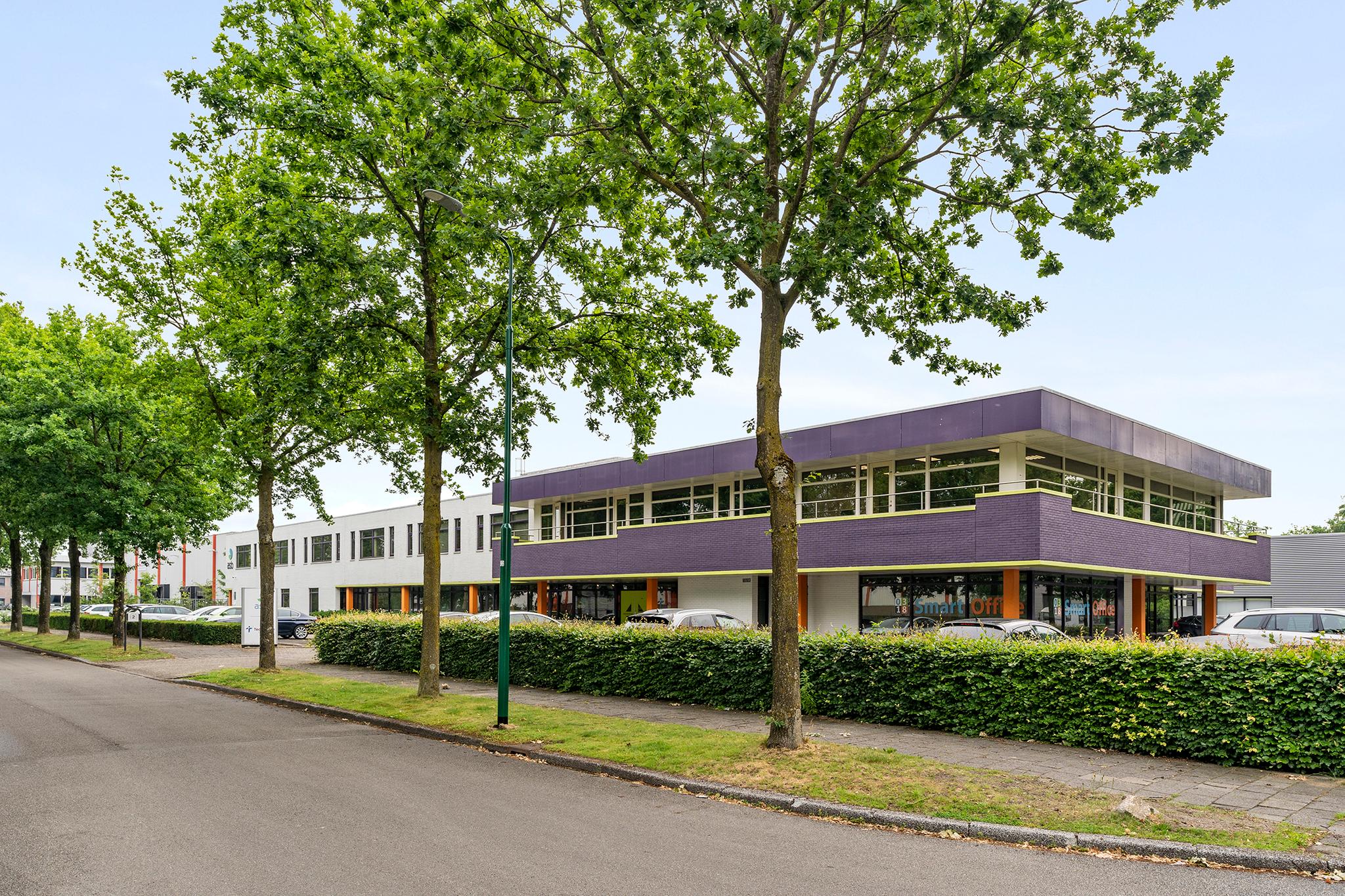This article provides a description in a nutshell of the method, as supported by VDMbee’s Strategyplanner. This method can be positioned as “Continuous Business Model Planning”. It focuses on rationalizing strategy, and assessing impact of that on the structures and value objectives of the business of the future. Its outcomes enable managerial decision making about innovation and transformation, based on underlying industry-standard value models and business ontology. Its outcomes also serve as inputs for productive change projects, both organizationally and in IT.
The following graphic gives a high-level impression of the stages of the model and what kind of (integrated) views are used during these stages.

Continuous Business Model Planning
The next picture suggest how this method can be applied organization-wise, collaboratively with the stakeholders in an initiative or engagement.

CBMP Method
Discovery
During “discovery” (its four sessions) we follow the following steps:
- First session: Sketch the ecosystem (business ecosystem map), based on ideas, facts, opinions, etc., of the people in the workshop. Determine, also based on consensus, in the group, for which key participants in the ecosystem (one, two, or just a few) we should “creep into their skin”, to prepare for modeling (in the next session) from their perspective, in relation to the others in the ecosystem. The purpose is to get focus, build common understanding, stimulate creativity in a structured way. It really serves as eye-opener during the workshop, and people are generally enthusiastic about it. After the session we work it up a little, and we also map the result into first skeleton of structured models for Prototyping, to ease the next step (next session).
- Second session: Per each of the key participants as determined in previous session, we create a business canvas (Business Model Canvas, or any known and Strategyplanner-supported variation to it). This is also based on consensus, in the group. This expresses, from each of these participants’ perspective, how they relate to the others in the ecosystem, and it provides more details about their interior organization to support their contribution. After the session, we work it up a bit, and we extend the mapping to the prototype models by the added information in the canvases.
- Third session: again, with the stakeholders, we define and build consensus on the value objectives to steer innovation and transformation efforts on. It is important to know, when you innovate or transform business, what value objectives you use, to measure your success on (or lack thereof ..). During this session understanding of the main influences (cause-effect) for these values is built as well, and we express this in Strategy Maps. Just roughly during the session. After the session, we work it up a bit. After the session (or maybe after the entire workshop), we work the essence of this into the details of the structured business models as derived from the earlier steps.
- Fourth session: as you can’t reach everything in one day, with the stakeholders we think about phasing the plan, as well as, for sake of risk mitigation and as you work with assumptions, to prepare for contingencies, and sketch alternatives.
Meanwhile, in each session, there can be discussion and feedback on the results so-far, which may lead to adjustments, etc.
As indicated above, during the period in which the workshop sessions are conducted, workshop results are mapped into structured models for prototyping. This is performed in a Strategyplanner-supported, interactive way. These models represent a set of interacting business models, of the key participants in the ecosystem. These models are structured based on the underlying value model and business (model) ontology.
Prototype
Then, after the discovery workshop (its four sessions), you sit by yourselves, as an analyst, to further massage and fine-tune these prototype models. Among others, essentials of Strategy Maps, as output of the workshop, are worked into these structured models, so that they become a fully and consistently integrated aspect of these models. This way, these models are not only suited as business blueprints for the future, but as well as basis for a dashboard towards the future, based on calculated impact on value objectives.
And this is all done in one, two, or at least a few sprints, following an agile approach. Whereby, during each sprint’s (week’s) evaluation with the stakeholders, you discuss results and findings with them. Basically you continue, till the stakeholders are sufficiently satisfied, and able to make their decisions, and get on implementing the plan in the real world. Default is two or three sprints (weeks).
As a part of this, these dashboards (into the future) will be presented to the stakeholders / decision makers. This is the beginning of “Adopt”. For this purpose we also have enabled light-weight experiments (scenarios), to play with. So that the stakeholders get good feeling for impacts and influences, and things get transparent to them. They may send you back to do more sprint(s) on prototyping, if they get more or different ideas to work into the model and to plan for, etc.
Adopt
Then, also in context of “Adopt”, when decisions are made, the actual change is initiated. Formally this is complementary to what Strategyplanner supports. But Strategyplanner models/plans provide useful inputs for that too, such as:
- Business blueprint(s). Based on these, the changes can be derived as input for change projects.
- Other software may take it over, to detail out solutions. E.g., for BPM, or software development, or HR-oriented software for role enforcement and training, etc. Call these “downstream developments”, starting from Strategyplanner outputs as inputs. Potentially we may even support this by some (maybe custom-made) transformations, which is possible, as models from Strategyplanner can be exported as instances of structured meta-models.
- Importantly: based on the new business baseline as implemented in real world, monitoring (metrics snapshots of actuals) can start, and fed back to Strategyplanner, for comparison of actuals versus plan, etc.
Hope this gives you a brief overview of the method that can be followed. Of course variations are possible, and you can do it your way. But what has been written above is how we follow the method in projects with our customers.

